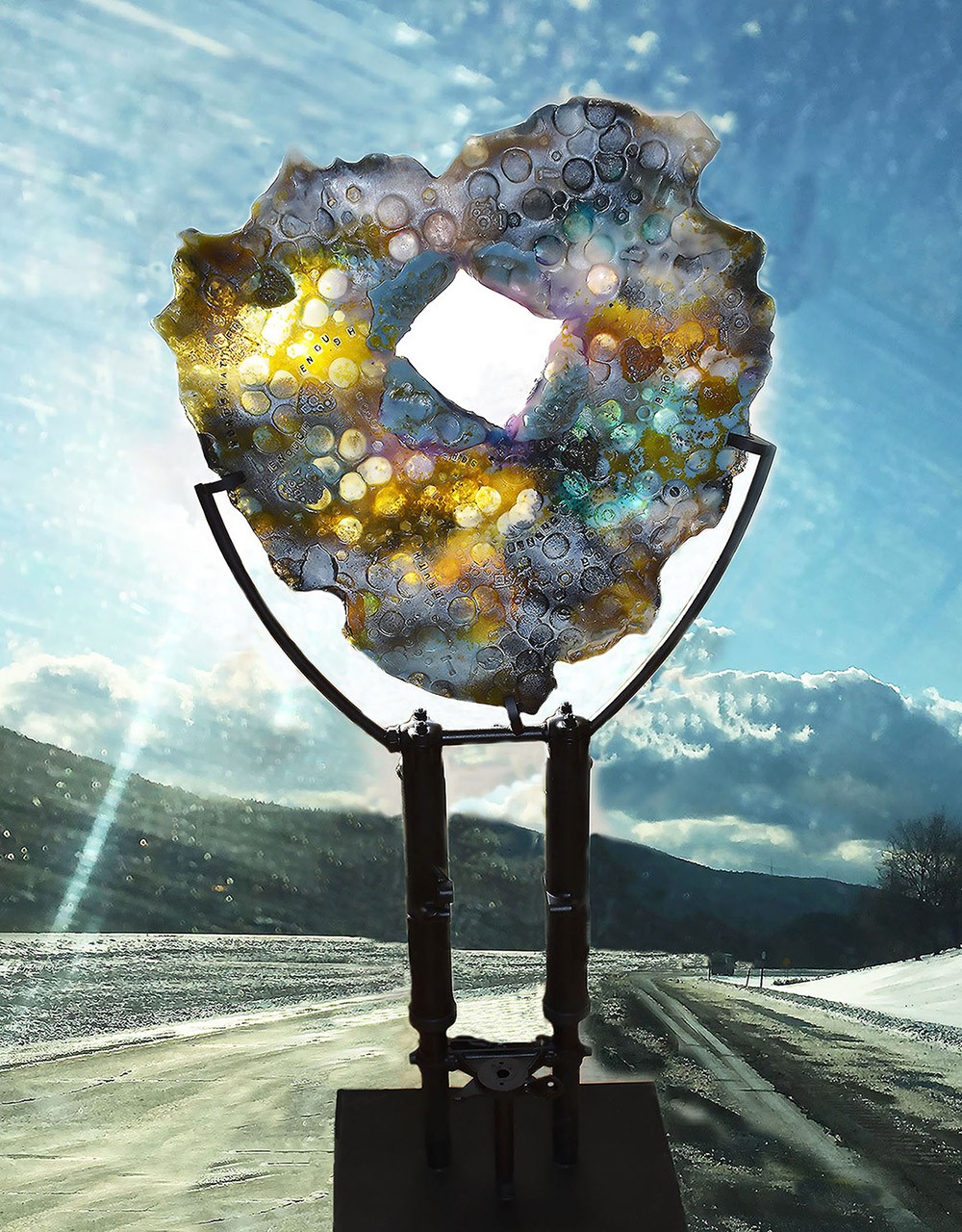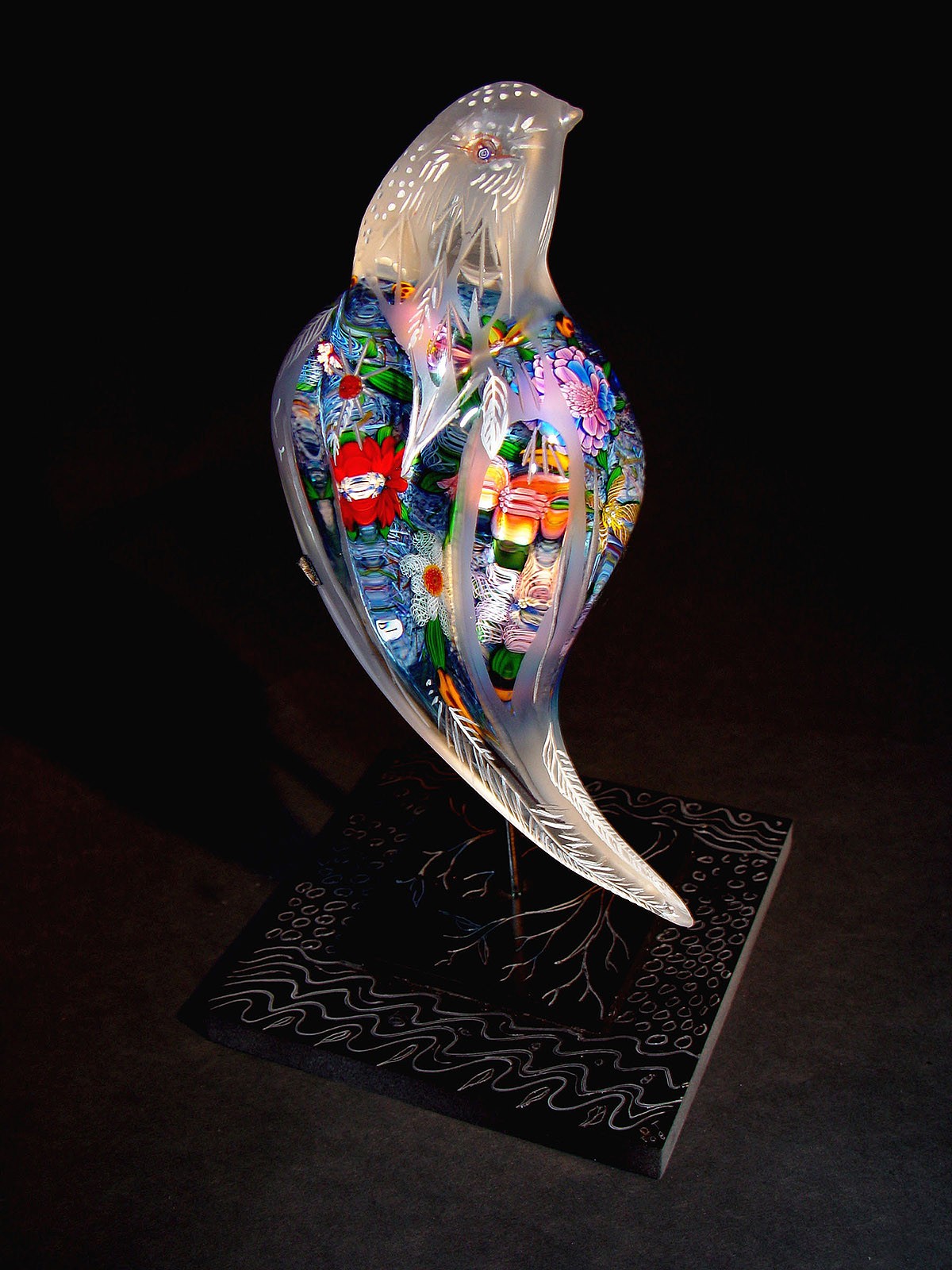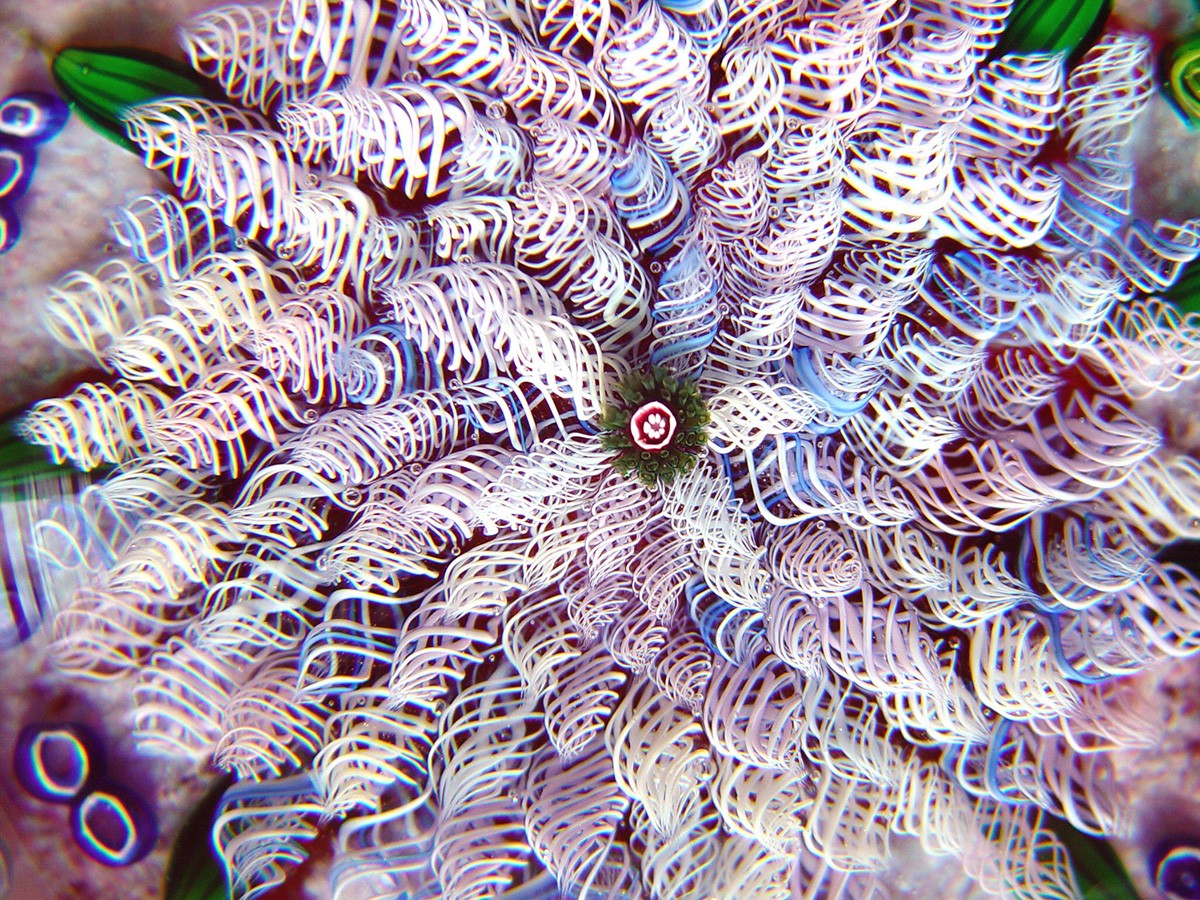
Image courtesy of Debbie Tarsitano.
Debbie Tarsitano
Artist Debbie Tarsitano (1955– ) studied painting throughout her youth and earned a BFA from Hofstra University in 1976. She and her father, Delmo Tarsitano, shared a passion for glass, first as paperweight collectors and then as makers of their own flamework weights. They taught themselves flameworking in their garage studio in Long Island. Since 2010, she has been creating narrative oil paintings with sculptural cast-glass elements. Tarsitano is based in Westford, Massachusetts.
Works

Nomad 13, 2020. H: 52 in, W: 0.5 in, D: 24 in. Image courtesy of Debbie Tarsitano.

Sapphire Bird, 2010. Image courtesy of Debbie Tarsitano.

Lacy Dahlia (detail), 1985. Image courtesy of Debbie Tarsitano.

Debbie Tarsitano discusses formulating a new softer glass for paperweights with Chris Buzzini and her father, Delmo.
Playing01:07 TranscriptDebbie Tarsitano discusses formulating a new softer glass for paperweights with Chris Buzzini and her father, Delmo. Oral history interview with Debbie Tarsitano by Barb Elam, conducted via telephone, April 18, 2019, Bard Graduate Center. Clip length: 01:07.
Debbie Tarsitano: Everybody made their weights from the glass my father and I created. Then later years, it must have been in the eighties cause my father was dead by ’91, an artist named Chris Buzzini and my father and I said we have to soften this glass, cause everybody was doing such dimensional work and this glass is hard to work with. And so we made a second formula with Schott, and Chris was very instrumental in this. We called it S8, and S8 was close to the glass we couldn’t get. And then we opened up S8 to everyone. And everybody was able to make their dimensional work then. And everybody began to make the work they wanted to make, and the way they wanted; it was a great glass to work with. And then even the people that had the lock on the glass had to buy S8, because they couldn’t order enough for the company to make it. We were like 10 to 15 artists that can order it together and make 10,000 pounds. So the people that wanted the little melts of their own, they couldn’t make that anymore. And so we wound up having that made for everybody.
PermalinkDebbie Tarsitano speaks about her pushing the idea of encasement. Oral history interview with Debbie Tarsitano by Barb Elam, conducted via telephone, April 18, 2019, Bard Graduate Center. Clip length: 01:49.
Debbie Tarsitano: Well, paperweights was evolving. I was one of the people that was hoping to evolve paperweights to join the contemporary art glass that—I’m talking about modern paperweights—to join the contemporary art glass scene. And I actually didn’t feel there was any reason why the modern artists today, the younger artists, who—that came around, shouldn’t be kind of pursuing the form differently, and to be looking at what’s being made by the contemporary artists in glass and other contemporary artworks, and try to find a way to take that idea of encasement and bring it into something else. And so I started to foster that idea in kind of a very forceful way, which didn’t go over very well with a lot of people because paperweights are relatively a traditional art form. And even when there’s cubes or, it’s not that far from what was made in the historical record. Cause there were plaques and things, and cut square things made in the historical record. So it’s like I wanted to bring it like, to the next place. And I worked very hard prior to like, 2009. I wrote articles about it, too, to try to say, ‘Hey, let’s, think of it as encasement.’ You’re encasing—flamework. Encased flamework—I like to think. And so we can take that flamework, and it doesn’t have to be flowers and things. It could be anything; we can open it up. It could be anything. And it could be flowers, but we need to think of like, how could it be a format for like, the times we live in. And so I pushed that a lot, and I started making a lot of forms, I made like bird forms, and abstract forms with encasement in it, and I painted the outside and sandblasted. And I did everything to a paperweight or a form that you could possibly think of.
PermalinkDebbie Tarsitano discusses The Corning Museum of Glass. Oral history interview with Debbie Tarsitano by Barb Elam, conducted via telephone, April 18, 2019, Bard Graduate Center. Clip length: 00:34.
Debbie Tarsitano: The Studio at The Corning Museum of Glass opened up this whole world for me. It’s like a—it’s the most extraordinary place on the planet for glass. And everybody comes there; it’s like the Mecca. And you can do whatever you want; they have every piece of equipment possible; they have every help possible. People come from all over the world, so you could be standing there and there’s somebody from the Middle East there working on something next to you, and it’s like—it’s just an extraordinary place. And I saw the freedom of being able to make anything that you wanted, and like, that was supposed to be good there.
PermalinkDebbie Tarsitano discusses Paul Stankard revealing his paperweight techniques.
Playing02:09 TranscriptDebbie Tarsitano discusses Paul Stankard revealing his paperweight-making techniques. Oral history interview with Debbie Tarsitano by Barb Elam, conducted via telephone, April 18, 2019, Bard Graduate Center. Clip length: 02:09.
Debbie Tarsitano: So paperweights—the secrecy of paperweights may have helped to develop versatility in paperweights. And little at a time it began to—what happened I guess when Paul started to teach, people were unhappy about that. They were like, ‘Oh, he’s showing people how to do this.’ And I didn’t really have any opinion at all, cause I was like, I didn’t care. You know, I come from the art world where I have teachers that show me how to paint, and do things. But a lot of people were like, “Oh, he’s showing them how to make this. This is bad.’ [laughs.] And yet people wanted to learn, and so he probably was the one that did start kind of showing the technique to others, but it went from the secrecy from the ancients, really. You know, you told somebody in Murano that they would kill you. I mean, you couldn’t get off that island. So it was like, it went from that and then slowly began to join contemporary glass. Contemporary glass, they would show you everything. I mean, ‘Come over, come on, yeah. Come and have lunch, and come in my studio. We’ll make something.’ So the spirit of contemporary glass, cause I think at the time, Paul—and I knew Paul, I’ve known Paul for many, many years, over 40 years probably. He went into the contemporary glass, and he met people, maybe because he was near Wheaton Village, which began to invite people for contemporary glass. So he began to see that world, and I’m not gonna say for sure that this is what happened, but I think if you see that world, that world teaches. The contemporary glass world will show you techniques and how you do things. So that was probably part of when he was in that, and we weren’t—he kind of went into that contemporary glass world, and we stayed with the paperweight world. You see there were two different—the paperweights are outside of contemporary glass, and still it’s a little bit hard today even today. But so I think that brought about, ‘Well, I’m seeing all these contemporary artists teaching, well, why shouldn’t I teach this?’ Which I think was probably the course of things.
PermalinkDebbie Tarsitano discusses her involvement in Paperweight Weekend and its history, being a woman glassmaker, and how she and her father learned to make paperweights.
Playing06:15 TranscriptDebbie Tarsitano discusses her involvement in Paperweight Weekend and its history, being a woman glassmaker, and how she and her father learned to make paperweights. Oral history interview with Debbie Tarsitano by Barb Elam, conducted via telephone, April 18, 2019, Bard Graduate Center. Clip length: 06:15.
Time stamp: 00:00
Clip 1: Debbie Tarsitano discusses the history of Wheaton’s Paperweight Weekend. Clip length: 01:59.
Debbie Tarsitano: This is not the first one that I attended. Wheaton Village would have it one year, and then the opposite year would be the Paperweight Collectors Association convention. And I started to go to this event from Wheaton Village, it started as the—and I could be wrong—but this is what I recall. It started as the American Paperweight Association. And they had it first I believe in a hotel around the Pennsylvania–New Jersey area. And then from that it grew into the Wheaton Village Paperweight Weekend. And I think they kind of dropped the idea of the American Paperweight Association because the Paperweight Collectors Association was everyone. It was people from the United States. It was our foreign colleagues in France and all over Europe that made paperweights. You know, encompassed everything. And then from that grew this idea, well, what about American paperweight artists and having their own association, and that, like I say, took place in the late seventies probably. And then from that Gay Taylor and the people at Wheaton Village made it into the Wheaton Paperweight Weekend. And at first it had as you can see all these American artists, but at some point it really just did open up to everybody. It did. They couldn’t just like, keep it just for the American artists. There were people from Scotland, Perthshire paperweights, Saint-Louis, the people from Saint-Louis and Baccarat and other European factories. But it was kind of like the early days of putting together, you know, associations that could gather people together that enjoyed paperweights and have the artists come, which is, I feel, a great—one of the great things that these associations did. They had the artists attend. So people could actually meet the people that made the work.
Time stamp: 02:02
Clip 2: Debbie Tarsitano discusses attending the Paperweight Collectors Association conventions with her father, Delmo. Clip length: 02:10.
Debbie Tarsitano: When I first started, I didn’t know anybody. And my dad attended a paperweight convention in Washington, D.C., and the date on that I’m not sure, but it was probably sometime in the late seventies. And when he went to the Paperweight Collectors convention in Washington, D.C. he heard about that there were these conventions and things, and gatherings. And he didn’t even sign in. He just went, he and my mom went. They didn’t know he had to like, sign in, and pay. And Mr. Paul Jokelson, when he met my father, he realized he was kind of a stowaway at the convention, and he invited him to stay. And that’s where my dad met a lot of people from paperweights and realized that there was this big group of people, and, you know, we should meet them and get to know them. And from that we began to get to know some of the people that made paperweights. There was a New England—we heard of a New England paperweight chapter, even though we lived in Long Island, and we decided, well, let’s go there. We took our little paperweights that we had just been making, and we brought them there. And we met everyone there, and saw that there was a big group of people that got together. They hadn’t had I don’t believe, like a New York chapter at the time. And that was the closest to us, even though it was a long, it’s a long ride from Long Island, we went. And so that’s when we met more people that collected paperweights and some of the dealers and things, too. So we became aware that there was this whole group of people interested. And then we started going to the auctions at Sotheby’s and Christie’s that had paperweights. They had—they actually had paperweight auctions. They were pretty extensive. I mean, they had their own catalog, which doesn’t exist today. And we started going to those auctions and then meeting also a lot of people there. but also L.H. Selman was very influential to us because my dad met him early on and was buying antique paperweights from him as a collector. And that’s how we also learned about the whole connection to these dealers that dealt in paperweights.
Time stamp: 04:14
Clip 3: Debbie Tarsitano discusses being a woman paperweight maker. Clip length: 00:37.
Debbie Tarsitano: That’s why I wanted to be better. Cause they were making really great work, and I know—now I realize maybe women would think because you’re a woman, you have to do better. But at the time I just wanted to be better, and kind of make something extraordinary that competes, and it was very competitive. I mean, we were really competing against each other. It wasn’t like, ‘I made something. Isn’t that nice?’ It’s like, ‘Well, you made something, now I’m gonna make this.’ And then they made something and said, ‘Oh, you made that. I’m gonna make this now.’ So it was fun, and it was very, very inspiring. It was a great time. Really a great time.
Time stamp: 04:50
Clip 4: Debbie Tarsitano discusses how she and her father, Delmo, learned paperweight making. Clip length: 01:24.
Debbie Tarsitano: Well, we studied the antique paperweights. We studied—got Paul Hollister’s book—I mean, and Mr. [Paul] Jokelson’s book. And then we were able to go to the auctions and handle paperweights, actually hold them in your hand and look at them. And we were fascinated to look at how they were made. We would look at them, and ‘How do you think they did that?’ And my father, until what, I think in about way in the seventies before we made paperweights, he took a glassblowing class, down in Queens [New York]. It was Milropa Studios. And he had a store—my father had an appliance store, and this glassblowing studio opened up, and he took a glassblowing class there. So he learned a little bit about hot glass. And I didn’t take the class, but I went with him. And then we met this young man at a fair that made those fun glass animals and things. And my father actually took a couple classes with him and made little bears and swans and things like that. And then he came home, and he said he wanted to make a torch in our—we have a little kind of outbuilding on our property. And so he put a little torch on a card table out there, and I started to play. He would learn how to make these little elephants and things and then—they were tiny, like one inch—and then I would play, too. And I could do it. I mean, he would show me, and then I would do it.
Permalink